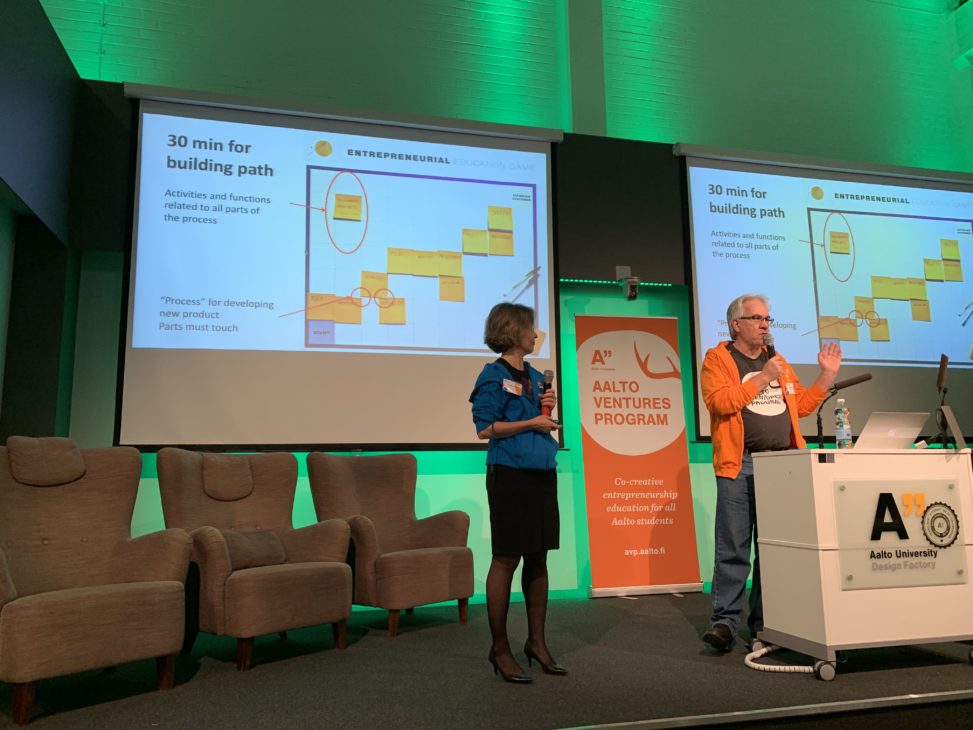Last month, I was at the University of Aalto in Helsinki to participate in activities related to entrepreneurship and innovation. This university is currently a reference in these fields that began with a student-led movement. In 2008 students founded the Aalto Entrepreneurship Society (Aaltoes), and managed to involve Tina Seelig, a well-known Stanford professor, as a mentor. In 2009 they started an acceleration program that is now called Startup Sauna and found that Aalto’s professors needed a better understanding on what was happening in entrepreneurship education in Silicon Valley. In 2011 they got the remarkable achievement of having Steve Blank spend a week in Helsinki. I have already written about Steve Blank in this chronicle (“Lean Startup: a New Diet?“) and his visit resulted in a brainwash of university leaders. The results are now visible with the annual creation of 70 to 100 companies in the Aalto ecosystem, accounting for about half of Finland’s university startups.
One of the most notable aspects of this transformation is its origins in a large number of students with the capacity to think and act in an innovative way. I do not see this innovative mentality so widespread among university students in Portugal. Is this one of the results of the well-known quality of education in Finland? When we evaluate the quality of education we think essentially on the knowledge transmission. Can learning processes convey knowledge and simultaneously change mindsets? Those owho teach innovation and entrepreneurship believe that it is.
Before proceeding with this chronicle, I propose that you use the questionnaire provided by the University of Berkeley and get a measure of your innovation mindset. I urge you to go to http://berkeleyinnovationindex.org, respond to the first questionnaire (Individual Survey) and provide at the end your email address to receive your evaluation report.
Now that you have answered the questionnaire I can explain to you how it was designed without influencing its results. The Berkeley Innovation Index was created based on the principle that there are sociopsychological behaviors common to entrepreneurs and innovators. From these behaviors, the ones that could be tested with questions already validated in previous works were selected. These questions were then assessed and selected for their efficiency in order to reduce redundancy.
As you may have seen, your results are presented in 7 dimensions. The first is trust, that is, your ability to trust others and their altruism. The resilience measures how to accept failure and error in a cycle of experimentation, analysis, and adaptation. The diversity evaluates your ability to connect and empathize with strangers. Mental strength indicates the confidence in your ability to change the world. Collaboration measures your openness to teamwork and your willingness to collaborate with your competitors. The measure of sensitivity to resources indicates your ability to perceive that perfect is the enemy of the good and that good enough is perfect. Finally, the size of the innovation zone measures your capacity to deal with uncertainty.
The application of this questionnaire to a 4-day entrepreneurship course in Berkeley with 100 students showed that there is a positive and significant effect on the results of the innovation mindset measured before and after the course. Other studies and other metrics show the positive effect of experiential learning models where students apply the acquired knowledge to problems with incomplete data, no single solutions, and near-real-life situations. One of the activities we held in Aalto was precisely the “Aalto Entrepreneurial Education Summit” where we involved professors from non-entrepreneurship courses from various European universities. The aim was to show them that well-designed learning models can help develop the innovative mentality of their students. For example, in the case of project-based engineering courses, it is advantageous for each group to develop a different project, with an incomplete specification, with a client or user other than the teacher and with different possible solutions. In this model, the role of the teacher is to validate the correct application of knowledge, allowing students the freedom to validate the solution with the client or the user. We expect that interventions of this type along the academic path of the student will have a significant impact on the capacity of innovation of future graduates. And has this chronicle changed your innovation mindset? You may check-it it by going back to the questionnaire.

 Português
Português